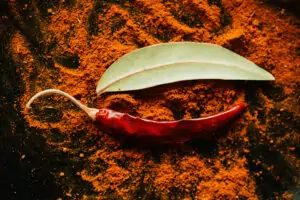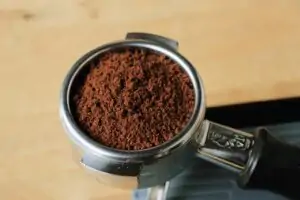Fancy eggs, anyone? Don’t be limited by paprika. This ground pepper comes in many forms, including a sweet version that isn’t hot at all. While a super-hot smoked version makes for an authentic Spanish paella, I’ve found Hungarian paprika and regular paprika as sprinkles on hummus and waffle fries. I recommend experimenting with this colorful, flavorful spice. Some have gone as far as sprucing up the tops of bran muffins!
What is Paprika?
Paprika is a powdered national spice made from ground red chili peppers. It’s a bright red spice with a spicy heat that ranges from mild to hot, and its flavor differs depending on the country where it is made. The word paprika refers to the spice, as well as the pepper it is made from and the plant that the pepper grows on.
Paprika peppers are native to Central Mexico, and were introduced to Spain in the 16th century. In Spain, paprika is spicy-hot and is called pimentón. The paprika trade also extended to Central Europe, specifically Hungary where it is a common cooking spice.
What is paprika made out of?
To make paprika, red chili peppers are picked when ripe and dried in the sun. Then they are ground into a fine powder. Depending on the paprika variety, the whole pepper including its seeds and other plant parts might be used, or the pepper without its seeds.
Varieties of Paprika
There are several varieties of paprika that have evolved over time, across continents. Here are the latest:
Smoked paprika
Known as the Spanish version of paprika, smoked paprika is made by smoking the pepper over oak. There are three varieties of smoked paprika: sweet, bittersweet, and hot.
Sweet paprika
This form of paprika is made of the pepper with the seeds removed.
Spicy paprika
Spicy paprika or hot paprika is made from the paprika pepper as well as its seeds and several other parts of the plant, including the stalks, are dried and ground together to give this spice more heat.
What is Hungarian Paprika?
The Hungarian twist to paprika has a sweet flavor. Spanish paprika and Hungarian paprika are not the same — the main difference is the smoky flavor, which Hungarian paprika lacks and with which Spanish paprika shouts.
It isn’t recommended to substitute Hungarian and Spanish paprika for each other because of their bold flavor differences, but as a garnish their differences won’t be noticed much.
What Does Paprika Taste Like?
There are several different types of paprika and they each have varying levels of heat depending on the spiciness of the peppers used. Spiciness is measured by the Scoville heat unit scale.
Spicy paprika can be as hot as 590 SV on the Scoville heat scale. This is generally a mild to moderate heat and is used for a variety of stews, soups, and curries.
Smoked paprika comes with a range of spiciness from 250 to 1,000 Scoville heat units, or mild to hot.
The sweet version of paprika is not spicy. It’s a mild paprika that doesn’t rate on the Scoville heat scale.
Where to Buy Paprika
Sweet paprika, regular paprika, or basic paprika is the most generic form of paprika found in the spice isle of nearly every grocery store, and of course, sweet paprika can be found online. Smoked paprika is often available too in the United States, in small jars next to regular paprika.
Hungarian paprika is more difficult to find at your general grocer, but is available online and at specialty spice shops. You can also look for Spanish or smoked paprika online or in spice shops if you’re unable to find it in your local grocery store.
How to Store Paprika
Store paprika in a sealed container in a cool, dark place like your kitchen cabinet for up to six months. Metal tins make the best containers for paprika. After six months paprika tends to lose its potency.
Cooking Substitutes for Paprika
There are several spices that can be used in place of paprika.
To substitute a spicy paprika, use equal quantities (ratio of 1:1) dried, ground chilis like cayenne pepper, crushed pepper flakes, red chili powder, or aleppo pepper powder. A dash of hot sauce for every 1/2 teaspoon of spicy paprika also works well.
To substitute smoked paprika, use equal quantities (ratio of 1:1) of ancho pepper powder or chipotle powder.
To substitute sweet paprika, substitute half (ratio of 2:1) the amount of chili powder, or in recipes that require only the sweetness, use four times the amount of tomato juice as sweet paprika powder (ratio of 1:4).
Best Ways to Cook with Paprika
Paprika is well-known as a spice used to sprinkle on deviled eggs, but there’s more. Spanish paella uses smoked paprika, and it’s delicious in Hungarian cuisine like chicken paprikash, goulash, and many other traditional Hungarian dishes, plus many recipes for vegetable and meat spice rubs.
Some of our favorite uses for paprika include this recipe for lobster tail, classic hard boiled eggs, and this recipe for super delicious tofu.
Several common and not so common pairings with paprika’s sweet version include eggs, potatoes (think egg and potato salad!), sage, pasta, stuffing, tomatoes, parsley, thyme, cumin, bay, asparagus, chicken, lentils, couscous, chickpeas, beef, squash, rice, and pasta.
Smoked paprika pairs well with brown rice, garlic, mushroom, black beans, olive oil, dijon mustard, cheddar cheese, and oregano.
Heating paprika unlocks its potent flavors, so remember when tasting your food that the overall flavor will be enhanced after heating.











